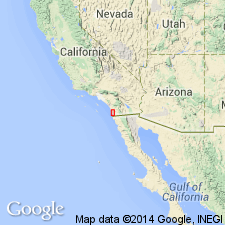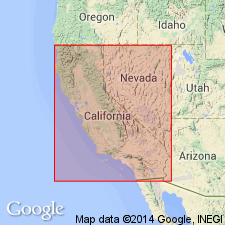
- Usage in publication:
-
- Scripps Formation*
- Modifications:
-
- Named
- Dominant lithology:
-
- Sandstone
- AAPG geologic province:
-
- Peninsular Ranges province
Summary:
Named as formation (of 6) in La Jolla Group for exposures along sea cliff north of Scripps Institution of Oceanography. Type section is on north side of mouth of Blacks Canyon about 1 km north of pier at Scripps Institution, San Diego Co, CA. Rocks have previously been included as part of Hanna's (1926) Rose Canyon Shale Member of former La Jolla Formation. Consists of pale-yellowish-brown medium-grained sandstone, containing in lower two-thirds three cobble-conglomerate beds. Is 67 m thick at type. Conformably overlies Ardath Shale (new) and in places Torrey Sandstone (both of La Jolla Group). Conformably underlies Friars Formation (new) of La Jolla Group. Age is middle and late Eocene based on molluscan fossils.
Source: GNU records (USGS DDS-6; Menlo GNULEX).

- Usage in publication:
-
- Scripps Formation
- Modifications:
-
- Biostratigraphic dating
- AAPG geologic province:
-
- Peninsular Ranges province
Summary:
Mollusks from "Domengine" and "Transition Stages" are listed with localities from Scripps Formation which indicate a middle Miocene age.
Source: GNU records (USGS DDS-6; Menlo GNULEX).

- Usage in publication:
-
- Scripps Formation*
- Modifications:
-
- Age modified
- AAPG geologic province:
-
- Peninsular Ranges province
Summary:
Age revised from middle and late Eocene to: middle Eocene based on stratigraphic relations as shown in correlation chart comparing Transverse Ranges with San Diego area and biostratigraphic zones of planktonic foraminifers and calcareous nannofossils.
Source: GNU records (USGS DDS-6; Menlo GNULEX).
For more information, please contact Nancy Stamm, Geologic Names Committee Secretary.
Asterisk (*) indicates published by U.S. Geological Survey authors.
"No current usage" (†) implies that a name has been abandoned or has fallen into disuse. Former usage and, if known, replacement name given in parentheses ( ).
Slash (/) indicates name conflicts with nomenclatural guidelines (CSN, 1933; ACSN, 1961, 1970; NACSN, 1983, 2005, 2021). May be explained within brackets ([ ]).

